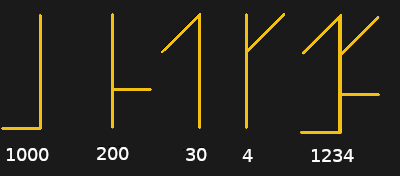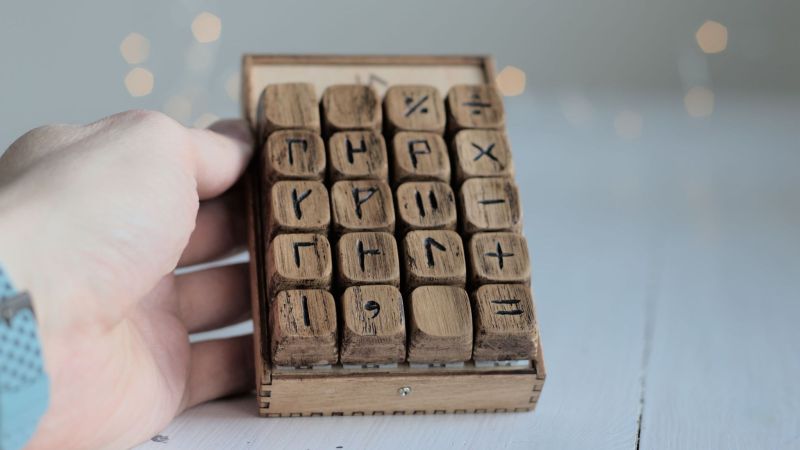Don’t feel bad if you don’t know what Cistercian numbers are. Unless you’re a monk of the Order of Cistercia, there’s really no reason for you to learn the cipher that stretches back to the 13th-century. But then again, there’s no reason not to use the number system to make this medieval-cool computer number pad.
If you haven’t been introduced to the Cistercian number system, it’s actually pretty clever. There are several forms of it, but the vertical form used here by [Tauno Erik] is based on a vertical stave with nine glyphs that can be attached to or adjacent to it. Each glyph stands for one of the nine numerals — one through nine only; there’s no need for a zero glyph. There are four quadrants around the stave — upper right, upper left, lower right, and lower left — and where the glyph lies determines the multiplier for the glyph. So, if you wanted to write the number “1234”, you’d overlay the following glyphs into a single symbol as shown.

[Tauno]’s Cistercian keypad, admittedly more of an art and history piece than a useful peripheral, somehow manages to look like it might have been on the desk of [Theodoric of York, Medieval Accountant]. Its case is laser-cut birch plywood, containing a custom PCB for the 20 keyboard switches and the Xiao RP2040 MCU that runs the show. Keycaps are custom made from what looks like oak combined with a 3D-printed part, similar to his previous wooden keycap macro pad. Each of the nine Cistercian glyphs is hand-carved into the keycaps, plus an imaginary glyph for zero, which wasn’t part of the system, as well as operators and symbols that might have baffled the medieval monks.
The native Cistercian system is limited to numbers between 1 and 9,999, so we’ll guess that the keypad just outputs the Arabic numeral corresponding to the Cistercian key pressed and doesn’t actually compose full Cistercian numbers. But the code to do that would be pretty easy, and the results pretty cool, if a bit confusing for users. Even if it’s just for looks, it’s still a cool project, and we doff the hood of our monkish robe to [Tauno] for this one.















If there is no zero glyph, how would one write the number, say, 1204?
If there is no 10’s value, you just omit the glyph for that quadrant.
No tens segment. An unadorned vertical line would be zero.
According to Wikipedia, which has a graphic with the numbers from 1 to 9,999, thusly:

Layer the glyphs for 1,000, 200, and 4, leaving the tens place empty.
So it’s not base9?
Wild, it’s like some shorthands, only vertical.
It’s another version of Roman numbers, those “Arabic” numbers with that nought hadn’t arrived yet, and there would be resistance of course. We in the US are still stuck in the Roman age with Ante-Post and no zero number for time whist the rest of the world can simply tell time. Our math scores on a world level show it.
Numberphile did an excellent video on this, which is where I learned about it:
https://www.youtube.com/watch?v=9p55Qgt7Ciw
Also, as the son of a historian who has written two books about the Cistercians, I feel obliged to point out hta tthey’re not the “order of Cistercia” but the “order of Cîteaux”.
That’s a wild pedigree.
And a very good video.
Their own website (www.ocist.org) says “Cistercian Order”. I think Cîteaux is the original place of order.
Online references seem to say they are officially “Order of Cistercians”, “Cîteaux” being merely a translation of the original “Cistercium” into something more easily pronounced by people speaking the newest language of the area. I suspect arguing about the name of something ridiculous that has existed for nearly a thousand years in many and various languages is a little pointless though.
So…
Their original monastery was a cistern?
B^)
That’s beautiful!
I’m dreaming now of a wooden keyboard and matching wooden thimbles to get the perfect sound to annoy my coworkers with!